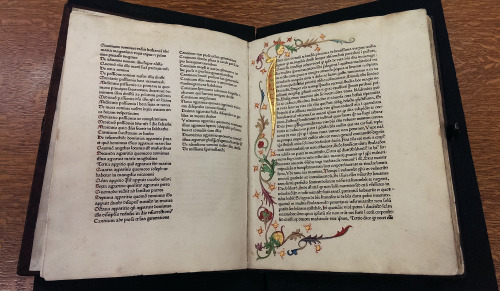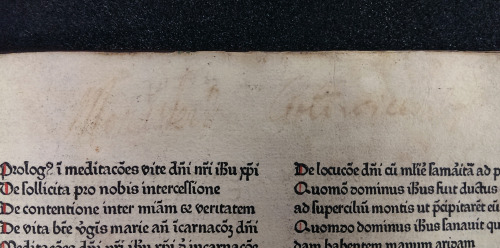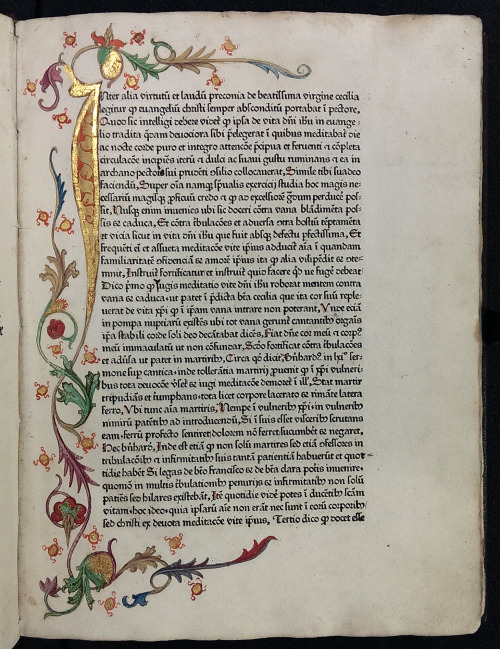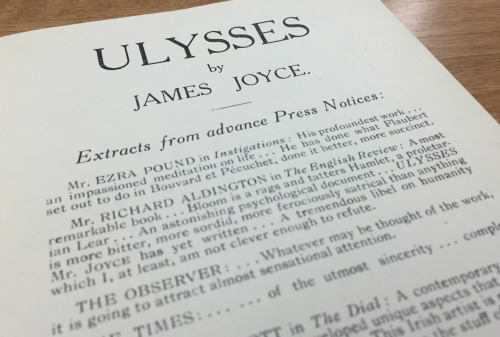#history of publishing
One way to measure the popularity of a given text is to count the number of times it’s been published. For example, the immense popularity of The Imitation of Christ, which went through 78 editions in the 15th century, has been said to trail only the popularity of the bible itself as a devotional text. Compare these to 15 editions of Dante’s Divine Comedy in the 15th century and one can begin to appreciate just how popular Christian devotional literature once was. As it happens, MSU has one of just eight known copies of a rare 1495 editionofThe Imitation of Christ.
Not far behind the popularity of The Imitation of Christ, with at least 65 editions appearing in the 15th century, is the Meditations on the Life of Christ. MSU is very fortunate to have recently acquired the first printed edition of the Meditations—the very first of those many editions to appear in the 15th century (pictured above). Published in 1468, this edition has the distinction of being the first dated book printed in the city of Augsburg—and this at a time when fewer than a dozen cities in all of Europe had the technology to print books. This first appearance in print is a fine complement to our medieval manuscript of the text, and it also claims the honor of being one of the three oldest printed books to reside in Michigan.
On the front paste-down of our Meditations, afloat in a sea of booksellers’ annotations, is the bookplate of Hieronymus Baumgartner (1498-1565), a powerful advocate of the Protestant Reformation. Baumgartner enrolled at the University of Wittenberg in 1518, the very town in which just a year earlier Martin Luther allegedly nailed his Ninety-five Theses to a church door. In Wittenberg, Baumgartner befriended prominent reformers Philipp Melanchthon, Georg Major, and Joachim Camerarius, and he later helped found the Melanchthon Gymnasium in his hometown of Nuremberg in 1526. Baumgartner was an accomplished statesman, to be sure, but we’re particularly pleased because his bookplate, as far as we can tell, is the oldest bookplate in MSU’s collection.
~Pat
This Provenance Project guest post was written by Patrick Olson, Rare Books Librarian at Michigan State University Special Collections.
Post link
We’ve probably all done this before. While out and about, perhaps while traveling or shopping, we lay a scrap of paper inside a book. Maybe it’s a receipt for the book’s purchase, or perhaps it’s a plane ticket. Whatever it is, we probably don’t give it much thought at the time. But decades later, or even centuries, those scraps of paper can prove more fascinating than the host book itself.
Not to discount Robert McAlmon’s first book, Explorations, but what we found laid inside our 1921 first edition was far more interesting: an early advertisement for Ulysses (as it happens, McAlmon edited Joyce’s Ulyssesmanuscript).
Early press for Ulysses more commonly manifests as a four-page prospectus that included a detachable order form. There were two versions of this that indicated Ulysses would be published in “Autumn of 1921”—just like our single-leaf advertisement (the book was finally published in 1922). One of these prospectuses bore the earlier address of Shakespeare & Co., 8 rue Dupuytren. The second of these prospectuses bore the new address, 12 rue de l’Odéon. Our advertisement here has the earlier address, though corrected by hand (someone please tell us if it’s Sylvia Beach’s hand!) to reflect the new rue de l’Odéon address. So with a bit of sleuthing and some help from The Poetry Collection at the University at Buffalo, we can confidently suggest that this rare Ulysses ad was printed about the same time as the first prospectus.
As you might expect, printed ephemera aren’t known for their survival skills. WorldCat locates two other copies of this particular ad, one each at Yale and Cornell. Surely there are others out there, safely filed away in archival collections—or perhaps just languishing inside an old book, a forgotten memento of a visit to a Paris bookstore in 1921.
~Patrick
This Provenance Project guest post was written by Patrick Olson, Rare Books Librarian at MSU Special Collections. Patrick joined Michigan State University in 2014, having previously held special collections positions at the University of Iowa, MIT, and the University of Illinois, where he also earned his MLIS. Prior to becoming a librarian, he spent four years working in the rare book trade.
Post link









